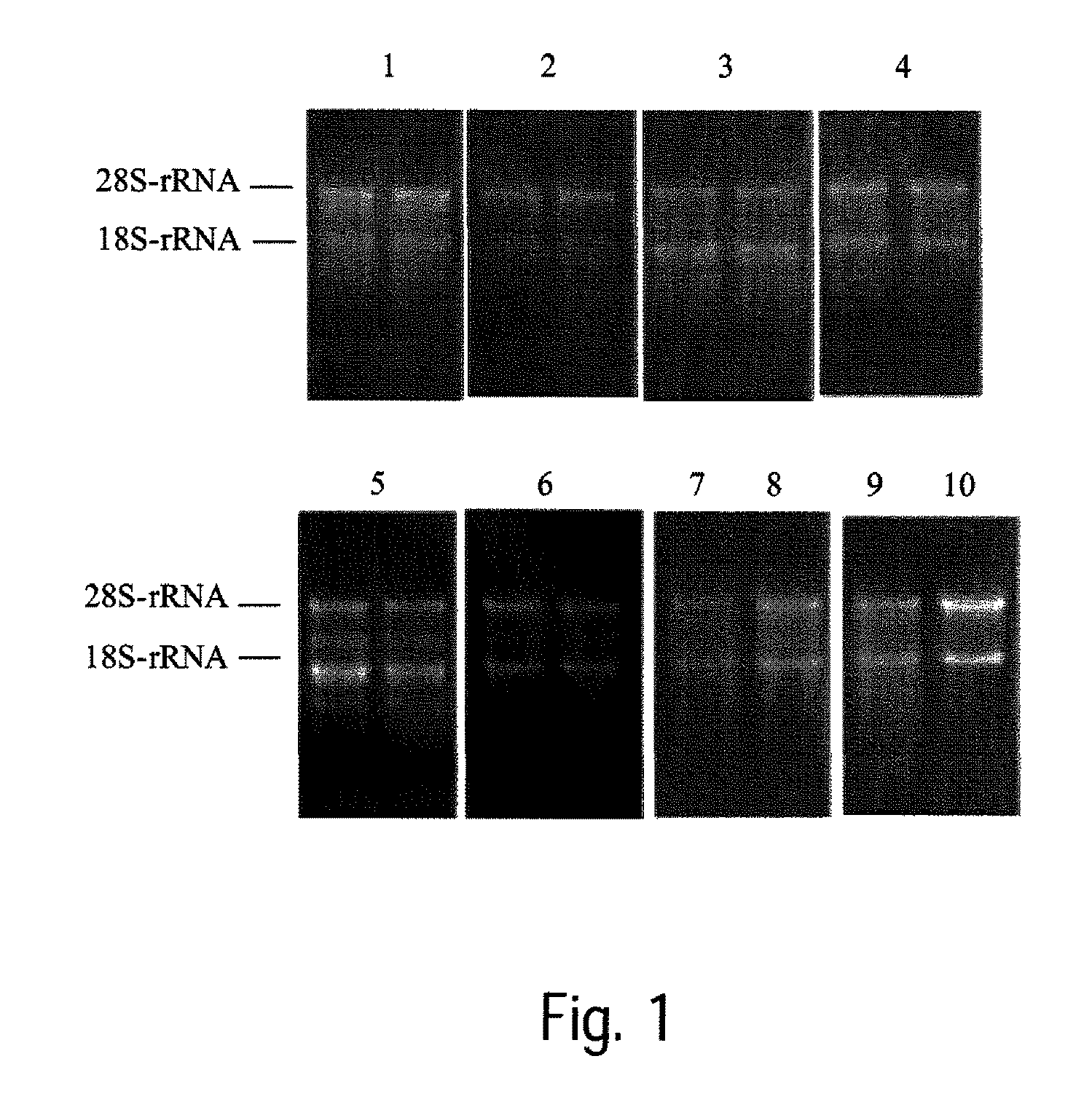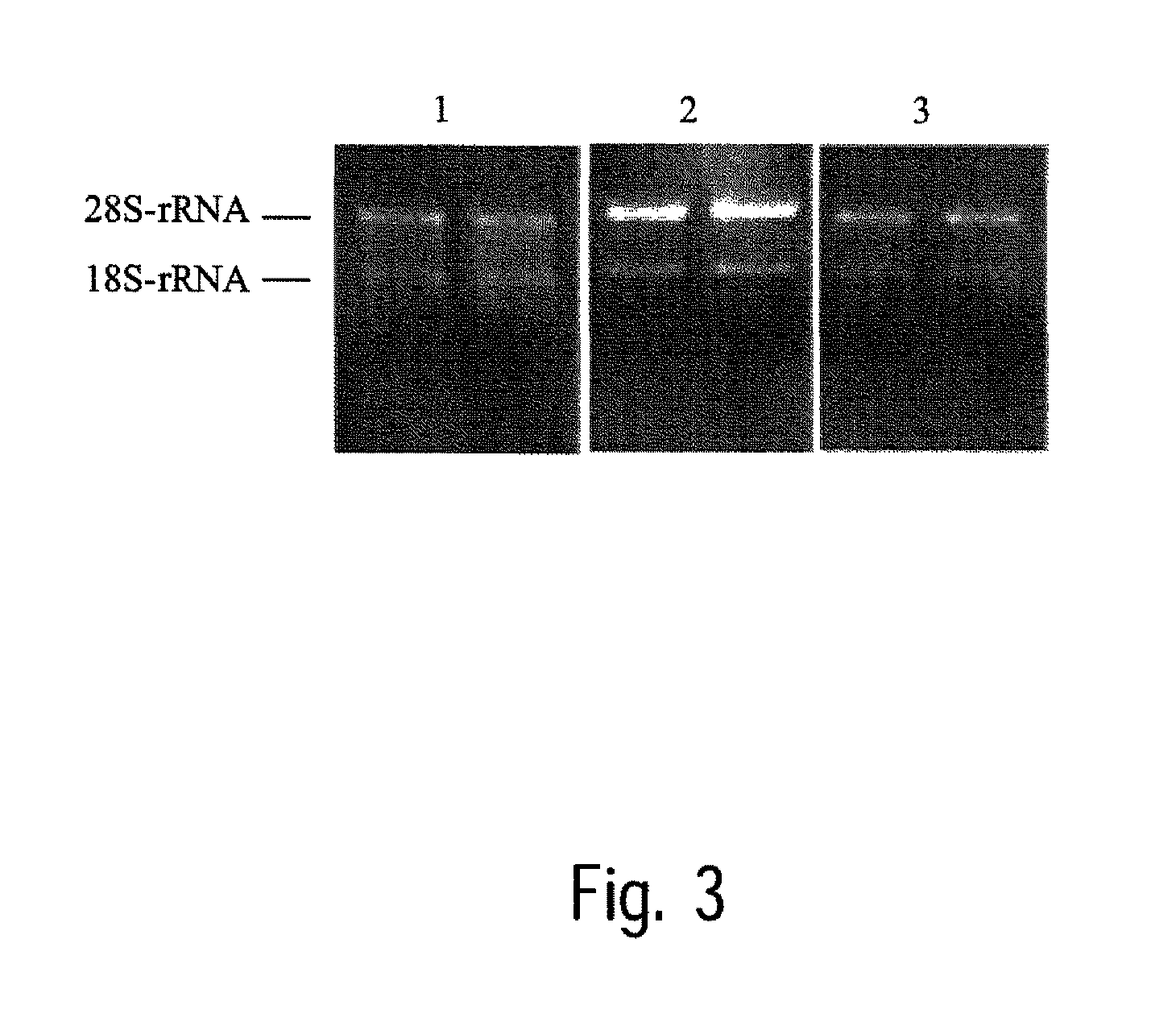Method for stabilising a biological sample
a biological sample and stabilizing technology, applied in the field of biological sample stabilizing technology, can solve the problems of difficult subsequent analysis of frozen sample material, individual constituents of sample material, and complicated logistic preconditions of methods,
- Summary
- Abstract
- Description
- Claims
- Application Information
AI Technical Summary
Benefits of technology
Problems solved by technology
Method used
Image
Examples
example 3
Transition with Mixtures of N,N-dimethylacetamide and Phenol
[0117]Rat liver tissue, which was frozen in liquid nitrogen after collection and then stored at −80° C., is used for this test. For each transition experiment, 20 to 50 mg of tissue is weighed and frozen, various non-cooled mixtures of N,N-dimethylacetamide and phenol (see Table 3) are added and the samples are stored for 3 days at room temperature. Following transition, the RNA is isolated as described in example 1.
[0118]The amount of total RNA isolated is determined, after dilution in water, by photometric measurement of light absorption at a wavelength of 260 nm. The quality of the RNA thus obtained is determined by photometric determination of the ratio of light absorption at 260 nm to that at 280 nm. The results of the isolation operations are shown in Table 3. The mean values of determination in duplicate are given in each case.
[0119]
TABLE 3RNA yield and quality according to photometric measurementTransition solutionS...
example 4
Use of N,N-dimethylacetamide as Additive for Improving Stabilization Properties
[0121]Rat liver tissue, which was frozen in liquid nitrogen after collection and then stored at −80° C., is used for this test. For each transition experiment, 20 to 50 mg of tissue is weighed and frozen, various non-cooled solutions are added and the sample is stored for 3 days at 2-8° C. in the refrigerator or for 1 day at room temperature (see Table 4). Following transition, the RNA is isolated as described in example 1. The RNA isolated is analyzed on agarose gels stained with ethidium bromide. For this, for example 1.0% formaldehyde-agarose-MOPS gels are prepared. In each case, 5 μl of the eluate is used.
[0122]
TABLE 4No.Transition solutionStorage1100% diethylene glycol3 d 2-8° C.295% diethylene glycol +3 d 2-8° C.5% N,N-dimethylacetamide3100% triethylene glycol1 d RT495% triethylene glycol +1 d RT5% N,N-dimethylacetamide5100% 1,2,3-propanetriol3 d 2-8° C.695% 1,2,3-propanetriol +3 d 2-8° C.5% N,N-dim...
example 5
Long-Term Storage with N,N-dimethylacetamide
[0125]Rat renal tissue, which was frozen in liquid nitrogen after collection and then stored at −80° C., is used for this test. For each transition experiment, 20 to 50 mg of tissue is weighed and frozen, various non-cooled solutions (see Table 5) are added and the samples are stored for 3 days and 5 days at 25° C. Tissue that was frozen in liquid nitrogen after collection and then stored at −80° C. serves as control. Following transition, the RNA is isolated as described in example 1. The amount of total RNA isolated is determined, after dilution in water, by photometric measurement of light absorption at a wavelength of 260 nm. The quality of the RNA thus obtained is determined by photometric determination of the ratio of light absorption at 260 nm to that at 280 nm. The results of the isolation operations are shown in Table 5. The mean values of determination in duplicate are given in each case.
[0126]
TABLE 5RNA yield and quality accordi...
PUM
| Property | Measurement | Unit |
|---|---|---|
| temperature | aaaaa | aaaaa |
| temperature | aaaaa | aaaaa |
| temperature | aaaaa | aaaaa |
Abstract
Description
Claims
Application Information
 Login to View More
Login to View More - R&D
- Intellectual Property
- Life Sciences
- Materials
- Tech Scout
- Unparalleled Data Quality
- Higher Quality Content
- 60% Fewer Hallucinations
Browse by: Latest US Patents, China's latest patents, Technical Efficacy Thesaurus, Application Domain, Technology Topic, Popular Technical Reports.
© 2025 PatSnap. All rights reserved.Legal|Privacy policy|Modern Slavery Act Transparency Statement|Sitemap|About US| Contact US: help@patsnap.com



